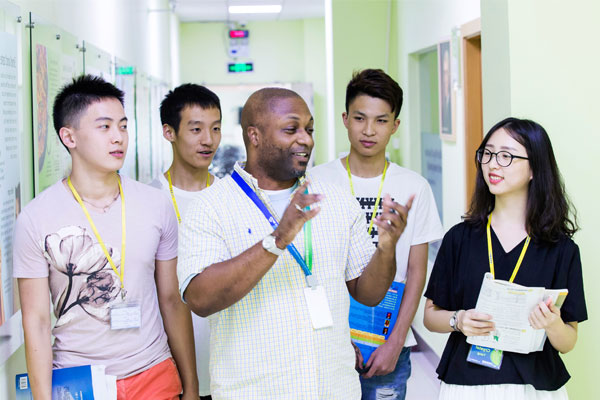时间:2017-06-12 12:14:35
来源:网络 作者:平和英语村
1.Turn “can’t” into “can if”
1 把“不能”变为“可能”
Problems make us feel paralyzed。 When you meet a roadblock, it’s natural to throw your hands up and want to walk away。 But next time you find yourself brainstorming on something and saying “We can’t because…” try starting the sentence “We can if…” instead。
各种问题麻痹了我们的神经。当我们遇到了障碍,自然而然地我们就想举起双手调头就走。但下次你发现自己在头脑风暴的时候在说“我们不能……是因为……”,换另一种说法:“我们可以……”
Here’s an example: Recently, my business Never Liked It Anyway made a venture into creating its own content。 We needed an army of talented writers。 Immediately, we waved the “We can’t because we don’t have money” flag。 It didn’t serve us very well。 Then, we shifted to thinking about options: “We can if… we identify talented, aspiring writers and offer them mentorship instead,” and “We can if… we align them to our vision of ousting Cosmopolitan magazine and invite them to be part of that journey!”
举个例子,最近,我的专栏Never Liked It Anyway冒险地增设了内容,我们需要许多有才的写手。很快的,我们举了“我们不能找到人因为我们没有资金”的白旗。这让我们的感觉都不会。然后我们转换了思维方式:“我们能够做到如果……我们找到了有才的,有激情的作家,并为他们提供培训来补偿。”或“我们能够做到如果……我们把他们与我们的大都会杂志的理念联合起来,并要求他们成为其中的一员!”
Simple, right? We now have five talented writers on our team, and we’re growing fast。
很简单,对吧?笔者的团队如今已经有5位才华洋溢的作家了,并且我们还在快速发展之中。
2.Access your assets
2 获得资产。
Ownership is becoming an antiquated concept, replaced by the shared economy。 Companies like Zipcar, Netflix, Songza, Rent the Runway, and Dropbox have smashed ownership into oblivion。 This “access” mode of thinking should apply to your business assets and resources, too。 Rather than thinking about what assets you own, consider what assets you can access。
所有权已经是一个过时的概念了,已经被分享经济所取代。诸如Zipcar, Netflix, Songza, Rent the Runway还有Dropbox这些公司都已经把公司的所有权粉碎得遗忘了。这个“通行证”的思维模式也应该应用在商业资产和资源之中。与其计算自己拥有多少资产,还不如考虑你能获得的资产有多少。
3.Ask impossible questions
3 提出不可能的问题。
Weirdly, in the context of innovation, impossible questions are more useful than hard questions。
Impossible questions collide the scale of your ambition with the problem itself。 This turbocharges creativity and catapults us into problem solving mode instantly。
奇怪的是,在谈论创新的语境中,不可能的问题比困难的问题来得更有用。不可能的问题使你的志向幅度和问题本身相碰撞。这样的涡轮式的压力所产生的创造力引发我们瞬间解决问题的可能。
4.Put constraints on yourself
4 严格约束自己。
We’re not always up against constraints。 In some parts of our working lives, we actually have it pretty good。 Ironically, this can be a challenge in itself and often results in us moving slowly and less creatively against our problem。
我们总不是一直面临着现在。在我们工作生活的一些部分,我们的确受到很大的限制。现实的是,这也能成为一项挑战并常常让我们在问题面前进度缓慢,创造力低下。
The solution? Put constraints on yourself。 That’s right: Deliberately limit your time, budget, or resources。 I’m in the process of launching a podcast series。 Each week, I watched it slide off my task list and land on next week’s to-dos。 Then, I decided to put a constraint on myself: Just spend 15 minutes each day working toward this goal。 Of course I have 15 minutes to invest in this project every day! In five days, I made more progress than I had in the previous five weeks。 Progress begets progress, and now the project has momentum of its own。
解决方法是?约束你自己。对的,故意限制自己的时间,资金或资源。笔者正在进行着播客系列的内容创建,每周我都会看着它在我的待办事项中消失,然后出现在下周的清单中。然后,我觉得给自己一些限制:每天只花15分钟完成这件事。当然我每天都有15分钟完成这件事!坚持五天后,我所取得的进步比之前5周的进步多得多,进步推动进步,现在这个栏目已经很受欢迎了。
So there you have it: four easy ways to up your innovation game。 Most importantly, remember that innovation is a habit。 The more you practice it, the easier this way of thinking, and being, becomes。 Next time you encounter an innovation-crushing roadblock, allow yourself to feel the frustration — and even a sense of resignation。 But then challenge yourself to overcome it and to actually embrace its limitation。 A Beautiful Constraint may sound like an oxymoron, but therein lies its challenge and effectiveness。
所以就这样:你有这4种方法来增加自己的创造力。最重要的是,记得创新是一个习惯。你越多加练习,创新的思维,创新的发现和创新的结果就会越来越容易出现。下次当你遇到一个创新障碍时,要让自己去感受这种焦躁的情绪,即使是辞职的想法。然后挑战自己的耐力去解决它,并接受它的局限性。“美丽的限制”听起来有点像双关语,但实际上它就隐含了挑战与效果。


